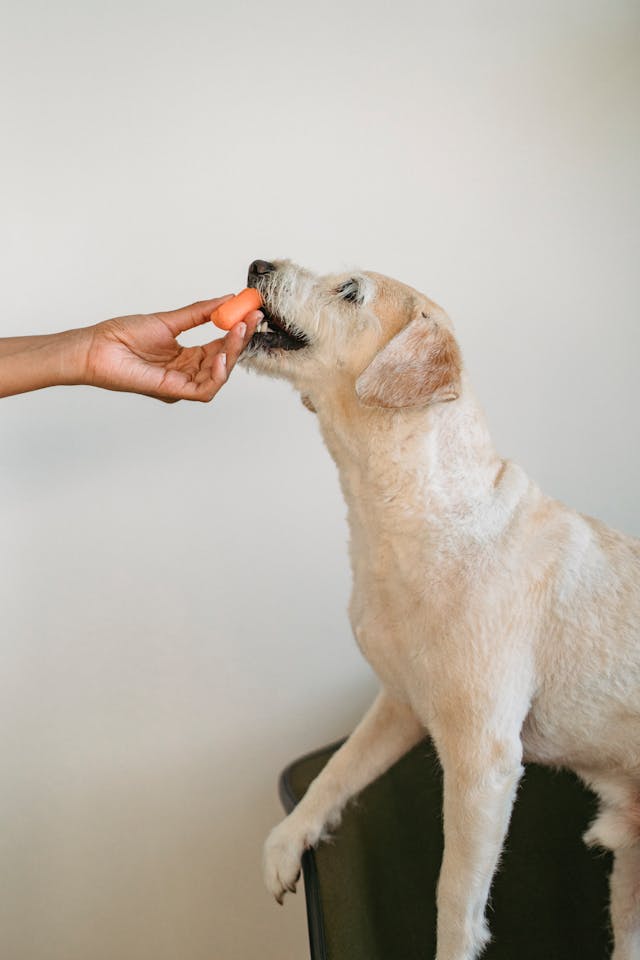Ensuring our animal friends have the right nutrients is critical to pet ownership. But because they are naturally interested, dogs frequently venture outside of their assigned food dishes and occasionally even indulge in a snack of cat food. Can cat food harm a dog, one wonders? This thorough investigation will go into the nuances of canine vs feline nutrition and look at the possible advantages and disadvantages of dogs eating cat food.
Recognizing the Dangers
Nutritional Imbalance: Cat food is painstakingly designed to satisfy the particular nutritional requirements of cats, which are very different from those of dogs. Dogs are omnivores with more varied dietary needs than cats, who are obligate carnivores and need a diet strong in protein, low in carbohydrates. Exclusive feeding of your dog or cat can lead to imbalances or shortages in nutrition, endangering their general health and welfare.
More Protein: The protein level is one obvious difference between dog and cat food. Higher protein content in cat food is usually justified by a cat’s hunting instinct. Although your dog needs protein, too much of it can put a burden on his liver and kidneys and result in long-term health problems like kidney disease or urinary tract difficulties.
The fat level of cat and dog food is another important distinction. Higher fat content in the diet is needed by cats for energy. On the other hand, if dogs often eat cat food—which frequently has a greater fat content—they could be more susceptible to weight gain and pancreatitis. Unchecked, this imbalance can result in obesity and associated health problems.

Taurine Deficiency: Meat has the most taurine, an amino acid essential for heart and eye health. While taurine is sometimes added to dog kibble to satisfy canine needs, canines may not get enough from cat food. Dogs suffering from chronic taurine shortage might develop serious cardiac and visual problems, which emphasizes the need of a well-balanced diet catered to their requirements.
Cats and dogs have different digestion enzymes and processes. Your dog’s gastrointestinal system is delicately balanced, and eating cat food can upset that equilibrium and cause symptoms like bloating, vomiting, or diarrhea. These symptoms can be painful and point to underlying medical problems that need to be seen by a veterinarian.
A Future Advantage
Palatability: Because cat food has more fat and protein than their own, some dogs find it more appetising. Picky eaters and pets with medical issues that impair appetite may find this especially helpful. Though your dog might find cat food appealing, you should put their long-term health ahead of their present pleasure.
Short-Term Fix: In an emergency when dog food isn’t available, your dog can get by on little amounts of cat food. This should just be done temporarily, though, as continued use can have negative health consequences.
Limited Ingredients: Compared to inferior dog food, some cat food variants may have more simple ingredient lists with less fillers or additives. Dogs with allergies or dietary sensitivities may find a more natural and acceptable substitute in premium cat food with few ingredients. But you should proceed carefully and under veterinary supervision.
Nutrient Variety: Including little amounts of cat food as a treat on occasion can help your dog get a wider range of nutrients. Its principal source of nutrition should be supplemented by this, not replaced. Finding a balance and making sure your dog’s diet is balanced overall and catered to its needs are crucial.

Managing Risks and Looking at Other Options
Supervision: The best defense against your dog’s possible risks of eating cat food is prevention. To avoid inadvertent intake, feed your dog and cat food apart and out of reach. Food transgressions can be reduced by setting up limits and teaching your dog to respect your food.
Balanced Diet: Choosing a premium dog food that satisfies your pet’s unique nutritional needs requires first consulting with your veterinarian. Your dog’s diet should take into account things like age, breed, degree of activity, and any underlying medical issues. Your dog’s general health can be monitored and food changes made as necessary with the help of routine veterinary examinations.
Transition Period: To reduce gastric discomfort and give your dog’s system time to adjust, switch them from cat food to dog food gradually over a number of days. To begin, gradually increase the percentage of the newest food by combining tiny amounts of it with their old. Over this transitional time, persistence and patience are crucial.
Occasional Treats: Give your dog occasional treats made of cat food; choose ones with few fillers and additives. Give your dog cat food treats only on exceptional occasions and make sure they make up a very small percentage of their diet. Their main nutritional source should be supplemented by treats, not replaced.

Schedule routine veterinary examinations to keep an eye on your dog’s general health and to handle any nutritional problems or concerns that may come up. Personalized advice and suggestions from your veterinarian can guarantee your dog receives the best possible nutrition and care all of its life.
Conclusion
In conclusion, extended use of cat food presents serious health and well-being concerns, even if the odd bite may not hurt your dog right away. Giving your pets the nourishment they need to flourish requires an understanding of the variations between cat and dog food and the particular dietary requirements of each breed.

Giving your dog a balanced diet catered to their requirements and way of life first priority will help to guarantee their long, healthy, and happy existence. Recall that the key to good nutrition for your pets is balance and educated decision-making. So the next time your dog longs to look into the cat’s bowl, fight the want to feed their curiosity and put their long-term health first. In years to come, your animal companion will appreciate it.



